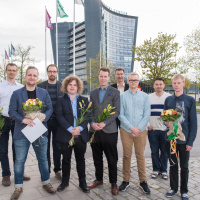News 2017
New Wilkes Stipendium awarded
The winner of the 2017 Wilkes Stipendium, a prize that is given to a female
student in one of our computer science and engineering related programs every
year, is Anna Montelius who studies in the second year of the Software
Technology degree program. She will be given the opportunity to travel to a
scientific conference with a staff member during 2018.
Read more
Detecting Unsolvable Planning Instances
Automated planning is a branch of artificial intelligence which deals with the
construction of plans. In his PhD thesis, Simon Ståhlberg studies unsolvable
planning instances, i.e. when there is no plan. Historically, this topic has
been neglected by the planning community, and up to recently the International
Planning Competition only evaluated planners on solvable planning instances.
For many applications we can know, for instance by design, that there is a
solution, but this cannot be a general assumption. One example is penetration
testing in computer security, where a system is considered safe if there is no
plan for intrusion. Other examples are resource bounded planning instances that
have insufficient resources to achieve the goal.
The main theme of the thesis is to use variable projection to prove
unsolvability of planning instances. Two planners are implemented and
evaluated: the first checks variable projections with the goal of finding an
unsolvable projection, and the second builds a pattern collection to provide
dead-end detection. In addition to comparing these planners to existing
planners, a large computer cluster is also utilised to statistically assess
whether they can be optimised further. On the benchmarks of planning instances
that was used, it turns out that further improvement is likely to come from
supplementary techniques rather than further optimisation. With the help of
isomorphic variables the thesis identifies a computationally tractable class of
planning instances that meet certain restrictions. There are several special
cases of this class that are of practical interest, and this result encompass
them.
Read more
Content Ontology Design Patterns
Ontologies are formal knowledge models that describe concepts and relationships
and enable data integration, information search, and reasoning. Ontology Design
Patterns (ODPs) are reusable solutions intended to simplify ontology
development and support the use of semantic technologies by ontology engineers.
ODPs document and package good modelling practices for reuse, ideally enabling
inexperienced ontologists to construct high-quality ontologies. Although ODPs
are already used for development, there are still remaining challenges that
have not been addressed in the literature. These research gaps include a lack
of knowledge about (1) which ODP features are important for ontology
engineering, (2) less experienced developers' preferences and barriers for
employing ODP tooling, and (3) the suitability of the eXtreme Design (XD) ODP
usage methodology in non-academic contexts.
Karl Hammar's PhD thesis aims to close these gaps by combining quantitative and
qualitative methods, primarily based on five ontology engineering projects
involving inexperienced ontologists. A series of ontology engineering workshops
and surveys provided data about developer preferences regarding ODP features,
ODP usage methodology, and ODP tooling needs. Other data sources are ontologies
and ODPs published on the web, which have been studied in detail. To evaluate
tooling improvements, experimental approaches provide data from comparison of
new tools and techniques against established alternatives.
The analysis of the gathered data resulted in a set of measurable quality
indicators that cover aspects of ODP documentation, formal representation or
axiomatisation, and usage by ontologists. These indicators highlight quality
trade-offs: for instance, between ODP Learnability and Reusability, or between
Functional Suitability and Performance Efficiency. Furthermore, the results
demonstrate a need for ODP tools that support three novel property
specialisation strategies, and highlight the preference of inexperienced
developers for template-based ODP instantiation?neither of which are supported
in prior tooling. The studies also resulted in improvements to ODP search
engines based on ODP-specific attributes. Finally, the analysis shows that XD
should include guidance for the developer roles and responsibilities in
ontology engineering projects, suggestions on how to reuse existing ontology
resources, and approaches for adapting XD to project-specific contexts.
Read more
Completion of Ontologies and Ontology Networks
Imagine we are interested in finding out how many Academy Awards nominations
and wins each actor in a movie has ever had. Trying to find this information on
the Internet would probably require visiting multiple websites, taken that none
of the existing websites provide this information directly. For example, we
would first need to visit the website containing the list of names of all
actors in the movie. Next, we would have to visit another website that might
have a list of Academy Award nominations over the years. Finally, we would then
be able to combine the information and count the number of nominations per
actor.
If this information is available on the Web, why cannot this query be
automated? Because of the current design of the Web, the information is not
directly usable by automated agents. The machine-readable content of a website
usually only contains the information needed to properly represent the website
in an Internet browser. One way to deal with this is to also include
machine-readable information which describes the content of the website. In
this way automated agents can understand the information a website contains.
Further, they can then relate and combine it with information on other websites
encoded in the similar manner and answer the query autonomously. This is one of
the goals of the Semantic Web, which is supposed to be an extension of the
current Web so that the knowledge and information is readable and
understandable by the machines. One of the technologies used to achieve this is
ontologies. Ontologies provide means for specifying the vocabulary used to
describe information on the Web. They enable defining terms and relations
between them, which an automated agent can then use to interpret the content of
the website. However, ontologies are often not complete which can lead to
incomplete results. In the cases where it is necessary to combine information
from multiple websites, such as in our example, it maybe the case that
ontologies use different terms to define the same concept. For example, one
website might use the term actor while the other might use the term artist to
describe movie actors. This heterogeneity makes it difficult to combine
information from multiple sources. Therefore, it is necessary to identify the
relationships between terms of the ontologies used by different websites. The
set of these relationships is called an alignment.
The focus of Zlatan Dragisic's PhD thesis is on completing ontologies and
ontologies networks, i.e. ontologies connected with alignments. High quality
completion of ontologies and alignments requires the user's involvement as
deciding if a certain relation holds in an ontology or between ontologies
requires knowledge of the domain the ontologies are describing.
Read more
Gated Bayesian Networks
A graphical model is a description of how different phenomena are related to
one another. The word graphical is used to stress that this description is done
using a graph, where the phenomena are depicted using nodes and relationships
are drawn as arrows. A graphical model might for instance describe how
different lifestyle choices relate to each other, such as physical activity,
alcohol consumption, nutritional intake and smoking. The graphical component
describes assumptions that are made in order to allow for efficient
representation and computation of certain quantities.
The real world is however not constant. Over time it may be required to switch
focus to other phenomena, or the relationships among the phenomena already
studied may change. If we are using a model that does not take such changes
into consideration we may end up with an underperforming model. In his thesis,
Marcus Bendtsen introduces a new graphical model which has the capacity to take
such changes into consideration. The new graphical model, which is called gated
Bayesian networks, is an extension of the popular graphical model Bayesian
networks. The new model combines multiple Bayesian networks and can choose
among them in order to maintain good performance.
The thesis introduces algorithms that allow for learning of gated Bayesian
networks from data. The algorithms vary depending on the goal of the learning
as well as the preconditions in terms of data and knowledge that is available
before the learning starts. For instance, it is shown how models can be learnt
that automatically buy and sell shares on a stock market in such a way that
risks towards the invested capital are severely reduced. The algorithms are
also applied to identify changes that occur over time, specifically when it
comes to changes in volatility of financial markets and professional athletes
performance.
Read more
Computational Complexity of Optimization Problems in Planning
Automated planning is known to be computationally hard in the general
case. Propositional planning is PSPACE-complete and first-order planning is
undecidable. One method for analyzing the computational complexity of planning
is to study restricted subsets of planning instances, with the aim of
differentiating instances with varying complexity. We use this methodology for
studying the computational complexity of planning.
Finding new tractable (i.e. polynomial-time solvable)
problems has been a particularly important goal for researchers in the area.
The reason behind this is not only to differentiate between easy and hard
planning instances, but also to use polynomial-time solvable instances in order
to construct better heuristic functions and improve planners.
We identify a new class of tractable cost-optimal planning instances by
restricting the causal graph. We also study the computational complexity of
oversubscription planning (such as the net-benefit problem) under various
restrictions and revealstrong connections with classical planning. Inspired by
this, we present a method for compiling oversubscription planning problems into
the ordinary plan existence problem. We further study the parameterized
complexity of cost-optimal and net-benefit
planning under the same restrictions and show that the choice of numeric
domain for the action costs has a great impact on the parameterized complexity.
We finally consider the parameterized complexity of certain problems related to
partial-order planning. In some applications, less restricted plans than
total-order plans are needed. Therefore, a partial-order plan is being used
instead. When dealing with partial-order plans, one important question is how
to achieve optimal partial order plans, i.e.
having the highest degree of freedom according to some notion of flexibility.
We study several optimization problems for partial-order plans, such as finding
a minimum deordering or reordering, and finding the minimum parallel execution
length.
Read more
Prize for best Bachelor and Master theses
The prize for the best master and final year project thesis during 2016 was
awarded in cooperation with the Computer Society (East). The winner at Bachelor
level is Tim Hultman and at Master level August Ernstsson.
Read more
Enhancing public sector capability to make use of design

There are many initiatives taken across the world to encourage the use of a
design approach to development and innovation within public sector. In relation
to this trend there is a need to improve the understanding of how public sector
organizations develop ability to exploit design; how they develop design
capability. This is the focus of Lisa Malmberg's thesis, which through an
exploratory study has observed two initiatives aiming to introduce design and
develop design capability within healthcare and social service organizations.
One main contribution of this work is an understanding of the design capability
concept based on a structured review of the use of the design capability
concept in the literature. The concept has previously been used in relation to
different aspects of designs in organizations.
Another important contribution is the development of an understanding for how
design capability is developed based on interpretations founded in the
organizational learning perspective of absorptive capacity. The study has
identified how different antecedents to development of design capability have
influenced this development in the two cases. The findings have identified
aspects that both support and impede the development of design capability which
are important to acknowledge and address when aiming to develop design
capability within a public sector organization.
In both cases, the set up of the knowledge transferring efforts focus mainly on
developing awareness of design. Similar patterns are seen in other prior and
parallel initiatives. The findings however suggest that it is also important to
ensure that the organization have access to design competence and that
structures like routines, processes and culture support and enable the use of
design practice, in order to make design a natural part of the continuous
development work.
Read more
Analysing adaptive performance to improve safety in complex systems
To cope with variations, disturbances, and unexpected events in safety-critical
work, such as cockpit operations and crisis management, people are required to
continuously adapt to the changing environment, sometimes in novel and
innovative ways. In her thesis, Amy Rankin examines what enables and disables
successful adaptations, and how contextual factors shape performance. Examples
include a crisis command team dealing with the loss of key personnel, a crew
coping with unreliable system feedback in the cockpit, and a nursing team
managing an overload of patients.
Two main contributions of the thesis is the analysis of cases of people coping
with variations and disturbances, and the development of conceptual models to
report findings, structure cases, and make sense of sharp-end adaptations in
complex work settings. The findings emphasise that adaptive performance outside
procedures and textbook scenarios at the sharp end is a critical ability to
cope with variation and unexpected events. However, the results also show that
adaptations may come at the cost of new vulnerabilities and system brittleness.
Analysing adaptive performance in everyday events informs safety management by
making visible limitations and possibilities of system design, organisational
structures, procedures, and training.
Read more
Energy-Efficiency in many-core stream processing
From Social media to scientific research, from mobile multimedia to Internet of
things, there is an overwhelming need to process more data faster, while
targetting energy sobriety. In his thesis, Nicolas Melot explores the Crown
Scheduling technique and designs the Drake programming framework in order to
build energy-efficient stream programs for many-core processors.
Read more
Page responsible: Webmaster










